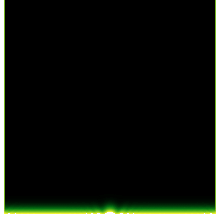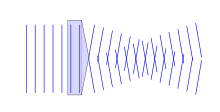



A Bessel beam is a wave whose amplitude is described by a Bessel function of the first kind.[1][2][3] Electromagnetic, acoustic, gravitational, and matter waves can all be in the form of Bessel beams. A true Bessel beam is non-diffractive. This means that as it propagates, it does not diffract and spread out; this is in contrast to the usual behavior of light (or sound), which spreads out after being focused down to a small spot. Bessel beams are also self-healing, meaning that the beam can be partially obstructed at one point, but will re-form at a point further down the beam axis.
As with a plane wave, a true Bessel beam cannot be created, as it is unbounded and would require an infinite amount of energy. Reasonably good approximations can be made,[4] however, and these are important in many optical applications because they exhibit little or no diffraction over a limited distance. Approximations to Bessel beams are made in practice either by focusing a Gaussian beam with an axicon lens to generate a Bessel–Gauss beam, by using axisymmetric diffraction gratings,[5] or by placing a narrow annular aperture in the far field.[3] High order Bessel beams can be generated by spiral diffraction gratings.[6]
- ^ Garcés-Chávez, V.; McGloin, D.; Melville, H.; Sibbett, W.; Dholakia, K. (2002). "Simultaneous micromanipulation in multiple planes using a self-reconstructing light beam". Nature. 419 (6903): 145–7. Bibcode:2002Natur.419..145G. doi:10.1038/nature01007. PMID 12226659. S2CID 4426776.
- ^ McGloin, D.; Dholakia, K. (2005). "Bessel beams: diffraction in a new light". Contemporary Physics. 46 (1): 15–28. Bibcode:2005ConPh..46...15M. doi:10.1080/0010751042000275259. S2CID 31363603.
- ^ a b Durnin, J. (1987). "Diffraction-free beams". Physical Review Letters. 58 (15): 1499–1501. Bibcode:1987PhRvL..58.1499D. doi:10.1103/PhysRevLett.58.1499. PMID 10034453.
- ^ Cox, A.J.; D'Anna, Joseph (1992). "Constant-axial-intensity nondiffracting beam". Optics Letters. 17 (4): 232–234. Bibcode:1992OptL...17..232C. doi:10.1364/OL.17.000232. PMID 19784285.
- ^ Jiménez, N.; et al. (2014). "Acoustic Bessel-like beam formation by an axisymmetric grating". Europhysics Letters. 106 (2): 24005. arXiv:1401.6769. Bibcode:2014EL....10624005J. doi:10.1209/0295-5075/106/24005. S2CID 55703345.
- ^ Jiménez, N.; et al. (2016). "Formation of high-order acoustic Bessel beams by spiral diffraction gratings". Physical Review E. 94 (5): 053004. arXiv:1604.08353. Bibcode:2016PhRvE..94e3004J. doi:10.1103/PhysRevE.94.053004. PMID 27967159. S2CID 27190492.